

Catch Fish with
Mike Ladle
Information Page
SEA FISHING
For anyone unfamiliar with the site always check the FRESHWATER, SALTWATER and TACK-TICS pages. The Saltwater page now extends back as a record of over several years of (mostly) sea fishing and may be a useful guide as to when to fish. The Freshwater stuff is also up to date now. I keep adding to both. These pages are effectively my diary and the latest will usually be about fishing in the previous day or two. As you see I also add the odd piece from my friends and correspondents if I've not been doing much. The Tactics pages which are chiefly 'how I do it' plus a bit of science are also updated regularly and (I think) worth a read (the earlier ones are mostly tackle and 'how to do it' stuff).
Lure fishing in the 2020s - Part VII
Salmon Facts and Figures
An exciting battle
It was a pleasant, mild, sunny, April day of the kind peculiar to South Dorset. I had been hoeing and weeding between the rows of peas on my small allotment and as I walked up the short road to my parked car I felt well satisfied with my efforts. Parked beside my car I found the familiar shape of the Vauxhall Chevette, belonging to my friend Jon Bass. I recalled that it was Jon’s salmon fishing day and, before driving home, I decided to walk across the field to a spot from which I had a good view of the river. The chances of seeing any action as a result of this impulse were very small but, as luck would have it, I could just see a figure on the bank about a half-a-kilometre upstream.
Being rather short-sighted I could not make out what was going on; however, there was something not quite right. Why was he (assuming that the figure was Jon) standing on the concreted area just upstream of the big gauging weir? Even if he was fishing in that unlikely spot, why did he not move on? With an angler's instinct I decided to walk up and see what was happening.
As I approached the weir it became apparent that Jon was not in fact casting and retrieving but standing quite still, rod held aloft, and bent towards some object in the River. I broke into a trot, and as I crossed the bridge over the weir, I shouted - “What is it?”- above the noise of the rushing water. At that moment Jon was too occupied to reply, but when I reached his side the picture became clear.
The fish was hooked one hour earlier and about thirty-metres further upstream. It had been immediately obvious that this was a very large salmon and, apart from one possible gaffing opportunity in the first couple of minutes, it had remained deep, swimming slowly upstream and then back down again until now it rested under the far bank, a metre or two above the weir.
I lay down on the bridge and peered into the depths. The seven-centimetre, wooden, yellow-belly lure was clearly visible as it spun slowly on the trace half-a-metre beneath the surface. One-metre deeper, just above the flint-gravel bed, I could see the faint grey shape of a big spring fish, it's great fan of a tail waving gently, as it effortlessly held station against the strong flow. After a brief consultation it was decided that I should try to persuade the fish to go upstream, away from the hazard of the concrete weir supports, but I was unable to reach far enough down with the gaff to disturb it.
Eventually the fish itself decided to go for another leisurely swim upstream. Hugging the river-bed it covered about fifty or sixty metres, during which time we had only an occasional, tantalising glimpse of a broad back. Jon tried to apply a little more pressure; the salmon, clearly irritated by this tension, once again turned downstream. This time there was a purposeful air about its movements and, despite Jon's efforts to apply side strain it headed straight for the central arch of the bridge above the weir. All attempts to retard its progress were in vain and, as it became obvious that the salmon was about to descend into the weir-pool (at its second attempt), Jon opened the bale-arm of his reel. Taking the gaff, I ran to the centre of the bridge and hooked up the nylon line. Once the line was firmly in my grasp, Jon re-engaged the bale-arm and consigned his well-worn rod and reel to the river. Hand-over-hand I hauled the rod and reel through the arch, carefully hoisted it onto the bridge and handed it back into Jon’s eager grasp. He reeled up the slack line; the fish was still attached, and after a few words with me he decided to go down the North bank, thus avoiding a large hawthorn bush on the South bank of the pool.
The fish circled slowly, deep in the race, and we were both confident that it would be played out and landed in this arena. In the following half-hour it threatened once again to ascend the weir but was dissuaded by heavy side strain. Twice it rushed to the far side of the race, a distance of about thirty metres, and hurled itself clear of the water - a stupendous sight which brought gasps from us both.
Clearly the salmon was now tiring and, as is often the case with a weakened fish, it began to move downstream, using its massive flank to broadside the current. Jon had little control in the strong flow, but he was still confident that he would be able to coax it within reach of the gaff before long. It surged downstream under the far bank with the two of us walking abreast of it. The first doubts began to creep into our minds as we approached an impassable ditch on our bank, some four-hundred metres downstream of the weir pool. It was now or never! Jon tried to bully the fish across to the slack water at the end of the ditch, but it gained a new lease of life and started into a powerful downstream run. Jon’s face lengthened and grew pale as sixty metres of line were dragged off under maximum pressure. We were stranded at the end of the ditch and, unless the fish stopped, all was lost.
As though in answer to a prayer, far downstream the salmon made its third leap and thankfully the run stopped. Jon was left with the problem of what to do. Any attempt to drag the fish back upstream could trigger off another potentially disastrous run. It was obvious that we had to cross to the other bank of the river, but the only crossing point was the bridge, four-hundred metres upstream. I began to run up the bank, pounded over the bridge, and raced (well – what passed for racing) down the South side of the River.
When I arrived opposite the ditch, gasping for breath, I was relieved to hear that the fish had not moved. Javelin style, Jon risked all and threw the rod, butt-first, across the river. I picked it up, still in one piece, closed the bale-arm and began to wind up the slack line while Jon threw the gaff after the rod and set off on the long run. Waders and waterproofs are not the ideal kit for a sharp sprint and, with Jon still far upstream, I had recovered all the slack. I held my breath and peeked over the edge of the grassy bank where the line disappeared. There it was! The huge submarine of a fish resting just beneath the surface, close under the bank, in a small reed-fringed inlet well, within reach of the gaff. I glanced upstream again. Jon was still minutes away. What if the fish set off downstream again? There was an impassable road bridge a little further down. I made my decision, took the rubber off the point of the gaff and crept back to the bank.
It was all over in a couple of seconds; The gaff went home by the dorsal fin and I dragged the fish onto the bank and well away from the water's edge. I looked up apprehensively, wondering how my pal, still some distance away, would react to my actions. Jon slowed down to a walk and his sigh of relief was distinctly audible, even at that distance.
A couple of minutes later, when we had both recovered our breath, we stood drooling over the mighty fish and speculating on its weight. A check on Jon’s watch showed that the entire struggle had lasted three-and-a-quarter hours. The sun was going down as we took it in turns to carry the fish back to the car. The spring balance registered exactly 34.5lb; The biggest from the beat for many years and a fantastic experience for us both.
Neither of us had a camera in those days and it was long before mobile phones, so there are no pictures. A few years ago I had a long-drawn-out battle on my fly gear, and not far downstream, with a fish of well over over half the weight of Jon's - my pal Nigel took a few pictures. Here's one! At least it gives an idea of the size of the river.
This one took me a long time to land as well.
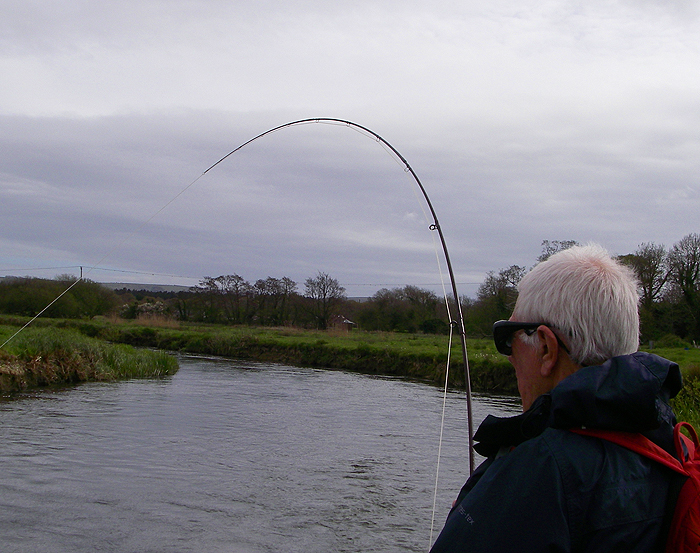
Even considering its size, this fish took an exceptionally long time to land - chiefly because of the circumstances under which it was caught. I have known other salmon, not much smaller, to virtually give themselves up within minutes. In fact, experience suggests that the best and most exciting battles were usually with small to medium-sized salmon caught when the river was heavily weeded.
Unfortunately, there is not much information available on the time taken to play and land individual fish so, since it is always of interest to compare angling results with those of other fishermen, I have tried a different approach. The catches of nine anglers (Harry and I are amongst them) are compared over a period of nine consecutive years. All fished on the same beat and, in any year, each was permitted (but did not always take advantage of) an equal share of the fishing time. First, I considered the number of salmon which they caught; as you might expect, there were good years and bad years for everyone. In some cases, indicated in the table by a blank, the person did not fish in that year. In 1976, a severe drought year, only eleven salmon were caught by seven anglers, whereas in 1981 forty-three fish were landed by nine of us. Only three anglers (1, 3 and 8) ever managed a double figure season’s catch.
Annual catches - yellow areas are years when an angler did not fish the river
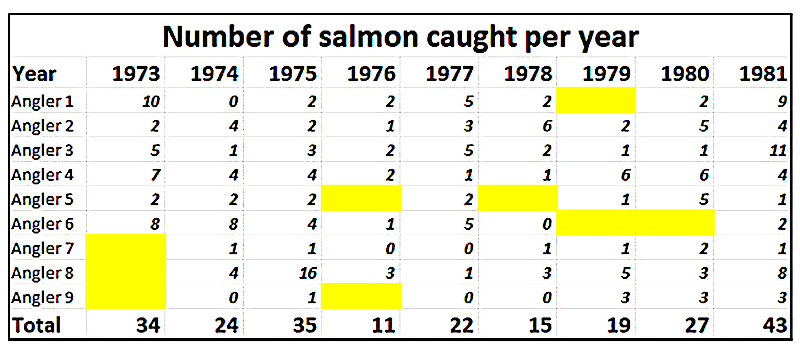
A second table shows the fishing effort, in rod hours, required for an angler to catch a salmon on this beat. Also shown are the number of fish caught by each and the rod-hours per fish in his worst years.It is striking that the number of rod-hours fished over the nine years range from two-hundred-and-three (angler 9) to five-hundred-and-seventy-nine (angler 8), (roughly a threefold difference); The number of fish caught varied from seven (angler 7) to forty-three (angler 8 ) (about 6- fold). Generally, the anglers spending least time on the river caught the least fish. Perhaps the most surprising fact is that the effort needed to catch a fish (by a given angler) was very consistent. For example, anglers 4 and 6 appeared to be the most efficient and, year in year out, averaged only 9.7 to 11.6 hours per fish; while angler 7, despite putting in roughly the same amount of total time, needed four or five times as long to catch a fish. The other anglers fell somewhere between these extremes.
Rod-hours of fishing needed to catch a salmon by the 9 anglers
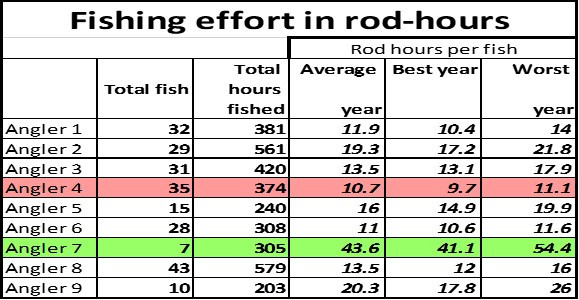
The reasons for such big differences are by no means clear. Obviously, luck plays a very small part, otherwise the results for a given angler would vary a lot more. The best lies are ‘common knowledge’, so simply knowing which bits of river are productive is of little value. This leaves two things of obvious importance. First, the more efficient anglers probably concentrated their efforts in periods when fish were relatively thick on the ground. Second, to average one fish per ten-to-twelve hours, it must have been necessary to make the most of every chance; few fish would have been lost and a minimum number of takes missed.
To anglers who fish for salmon on a top Scottish or Irish River, ten-hours-per-fish must seem pretty grim. However, the river in question was a chalk stream with an annual run of about two-thousand fish and a rod catch of about 200 (these days the total run is nearer to two-hundred). The reach fished is roughly a mile-and-a-half long and is only one of many similar stretches, but it produces twelve to thirteen percent of the catch for the whole River. With regard to fishing the ‘best’ time of the year; this can be very variable. Generally, May, June and July are the most productive months, while March and April produce fewer fish. However, the ‘spring’ fish caught in the early months are usually large salmon of fifteen to twenty-five pounds; some anglers are prepared to put in many cold and fruitless hours in the hope of catching a spring monster. (one local angler of our acquaintance had the fantastic experience of landing, in the space of a few weeks in early spring, three salmon, each weighing over thirty pounds).
A fresh-run spring salmon - note the violet stripe on the flank. This one was returned, fit and well.
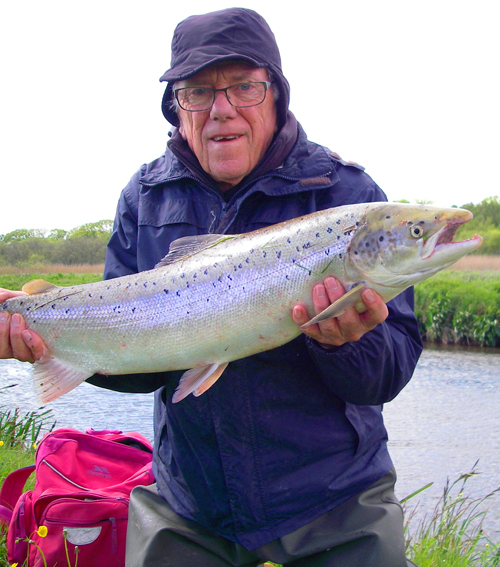
Finally, we examined the catch figures to see which methods had been used most successfully. It would appear that the lightweight, wooden Devons were the most effective ‘spinning’ lures on this river. However, this is not really a fair comparison because water authority bye-laws ban the use of plugs, prawns, and worms for the first ten weeks of the season. Against this, Devons are being used early in the year when less fish are present in the River. Overall, the table probably gives a reasonable picture. Of those lures which were permitted at that time of the year Devons are undoubtedly the easiest ones to use effectively. If plugs were permitted early in the season, they would certainly catch more than their fair share of large spring fish. As with many other species of predatory fish, baits will usually out-fish lures. In this case however baits don’t tend to select for larger fish – they simply catch more salmon for the amount of fishing effort.
Catches on different lures and baits in the 1970s - results depend mainly on the popularity of the method

A pink-shrimp, a treble hook, a paper clip (up the shrimps bum) and some thread tempt lots of salmon (bait-fishing was only allowed after mid June)
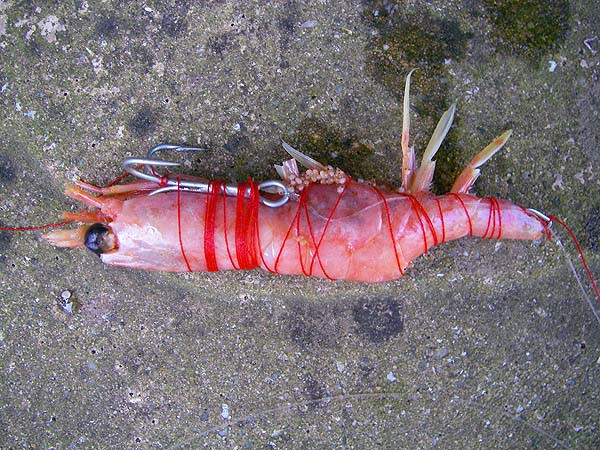
In conclusion, although certain amount of knowledge of the nature of a good salmon ‘lie’ can be an advantage, anyone with experience of spinning for other species of fish can be confident of catching a salmon on spinning gear, providing they have the time to spare and access to a salmon river where spinning is allowed.
A spring-salmon angler
It was the first day of March and rain was driving horizontally into Harry's face as he trudged along the riverbanks through the Brown, muddy pools deeply churned by the hooves of drinking cattle. A stronger gust of wind briefly halted his progress and sent a flurry of icy water from the cuff of his waterproof jacket into the open end of the sleeve, where it trickled from his rod-hand down his forearm and onto his flexed elbow.
By the ‘NO FISHING’ sign which marked the top of the beat he stopped and, after releasing the treble hook from the butt ring of his eleven-foot, hollow-glass, carp-rod, he cast the 3” yellow-belly and 30g bomb weight diagonally downstream, to land in the water under the far bank. Since he had started fishing four hours earlier, the water had risen and coloured perceptibly. Already he had changed from a 2” blue and silver, wooden Devon to the yellow-belly.
Half-an-hour later and one-hundred metres downstream of the boundary, still with no sign of a fish, thoughts of ‘calling it a day’ were running through his head. Perhaps just one last cast into the ‘Grayling Pool’, a spot where the river widened and deepened below a shallow, wide run. He held the rod almost vertical as the minnow swung across the tail of the pool, and then lowered the tip to within a foot of the water surface and slowly began to reel in. As the retrieve was completed the line slanted down steeply into the water, almost at his feet.
The cast was practically fished out-but, could that have been a knock? He lifted the tackle from the water and decided to have another ‘positively last’ cast.
Five last casts later, as the minnow swept round under the near bank, the rod plunged into a curve as a fish took firmly, hooked itself, and turned away downstream. The long rod bent more steeply, and Harry’s numb fingers fumbled with the clutch control on his fixed spool reel to ease the pressure slightly. As he began to wake up to the fact that he had, at last, hooked a fish his heart sank as his adversary rose to the surface and thrashed from side to side. He knew at once that it was a kelt.
A 'mended' kelt (female) - note the spawning colours still on the gill cover.
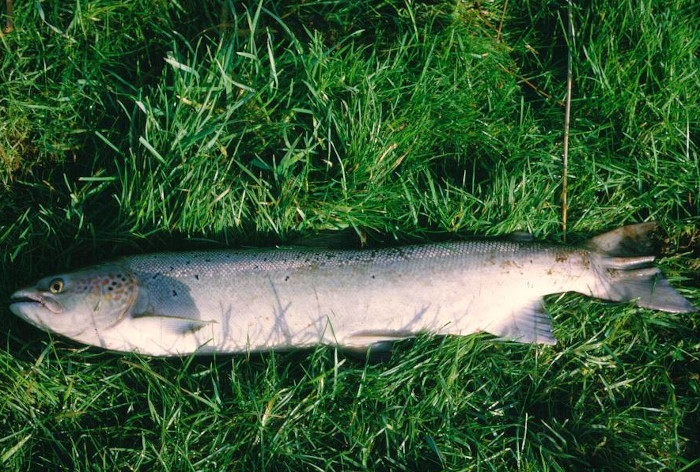
A dead, spawned salmon (male) - most males die and only a proportion of females survive
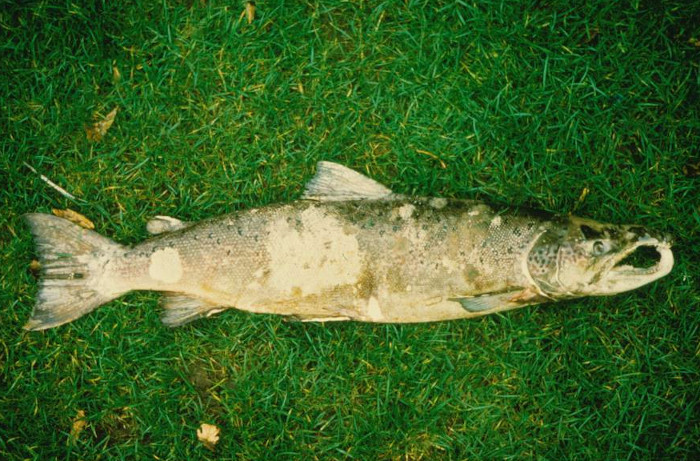
The battle was brief and a minute or two after the fish was hooked, it was tailed and slid onto the wet, grassy bank where it flexed its body and thumped the muddy ground with its tail. The flanks of the fish were bright, shining silver, but it was hollow-bellied, and on its ‘cheeks’ and gill-covers were a few red spots, relics of the spawning livery which it had flaunted only six weeks earlier. He returned it carefully to the water. Characteristically, he was encouraged by the capture of the kelt and fished on for a further hour, only packing in when the wind increased to force ten and he was in danger of being dumped into the swollen river by a sudden, squalling gust of rain-laden air. He had nothing to show for five-and-a-half hours’ fishing! Just one further comment about kelts. Fish caught early in the season, with a few red spots on the head region are not necessarily kelts. If they are fat and in good condition and/or have sea lice, they are probably fish which have spawned in earlier years and are returning from a second or third visit to the marine feeding grounds.
A well conditioned, early season, female salmon - the spots on the gill cover indicate it had spawned in a previous year
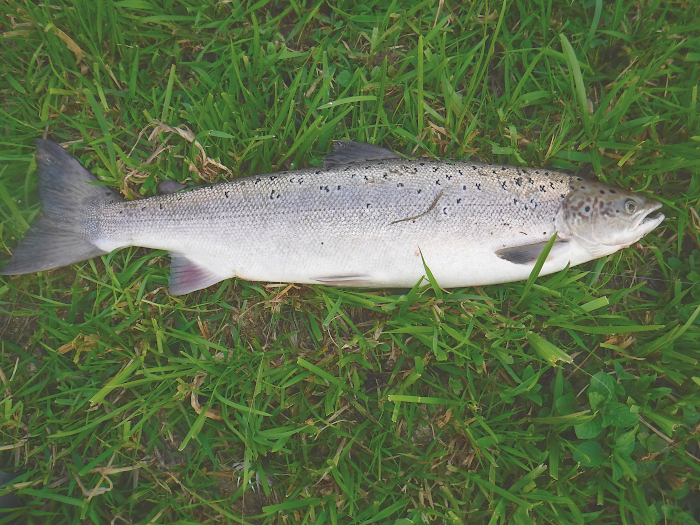
A 'baggot' - an egg-bound female fish which failed to spawn - note the flabby, distended belly
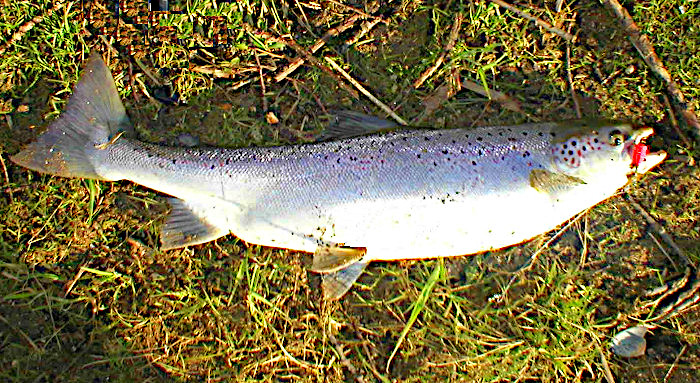
Harry fished for another 40 hours, in all, during March of that year and caught a further 9 salmon, all kelts, which he returned to the water with a variety of emotional comments. In the following year (1983) his reward for a cold, frosty, six o'clock start on a spring day, was a solid bite as his home-made blue and silver, wooden Devon swung across the tail of the Boundary pool. It was instantly clear that the fish was no kelt as it bored deeply towards the far bank. In the next ten minutes he followed it down through the shallows, where he caught a tantalising glimpse of a broad tail and purple tinged flank, then back upstream into the pool. Eventually it surfaced, wallowing on its side, close under the near bank, to be slid ashore. Harry unhooked his prize and checked his watch - 7:50 a.m. His broad grin suggested that he thought it was not a bad start to the season. With his confidence boosted he went on to catch three further spring fish before the end of April: the four salmon weighing 18, 16.5, 14 and 21 pounds.
A fresh-run salmon in good condition - this will be its first spawning season
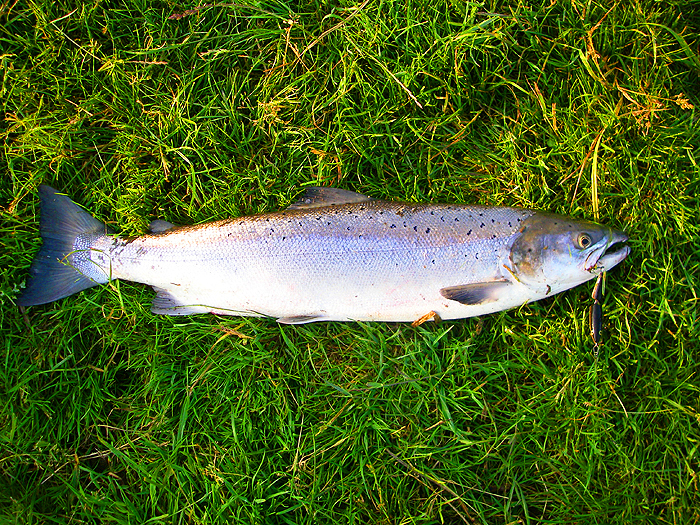
The attraction of the Devon minnow
The captures of the kelts and fresh-run spring-fish show not only the range of emotions which can be experienced in salmon fishing but also give some idea of the equipment suitable for catching large, powerful fish in smallish, deep and weedy rivers. All the fish were taken on that most traditional of salmon spinning lures, the Devon minnow. It is no accident that these simple lures are so popular because their form and construction have evolved largely for the purpose of catching one species - Salmo salar - at one stage in its life. This unusually specific approach to angling is worth considering in detail. First, we can examine the reasons for the effectiveness of the Devon minnow and the best design of lure and tackle for the job.
The materials of which the Devons are made can be taken item by item. First, the central tube may be either plastic (ballpoint pen refills are good) or metal. In either case the ends should be smoothly rounded without rough or sharp edges or fragments of hardened glue. A fast-spinning lure can quickly damage and weaken the nylon mount (which is, in all respects, superior to the fancy wire mounts often sold with commercially made minnows). Both metal and plastic tubes are satisfactory, the only difference being in density (weight), which should be borne in mind in relation to the conditions in which it is intended to fish and the volume and buoyancy of the material from which the body of the minnow is made.
Wooden, rubber and plastic Devon minnows are all OK for fishing in the fast-flowing water often associated with large spring fish. The ideal is a combination of tube, body, fins, hook, swivel, etc., which has neutral buoyancy (i.e., not much tendency to either float or sink). In general, the force of the flowing water will compensate to some extent for any deficiencies in this respect. Heavy lures will tend to ‘hang down’ and may snag the riverbed in moderate flow; light ones will ride higher than is desirable and will also require more lead to take them down to the riverbed. Ideally, the height of the lure above the gravel should be controlled only by varying the length of drop from the swivel to the lead, so neutrally buoyant lures are best.
A small selection of home-made, wooden, Devons with ballpoint-tube middles and chocolate-wrapper, gold coating
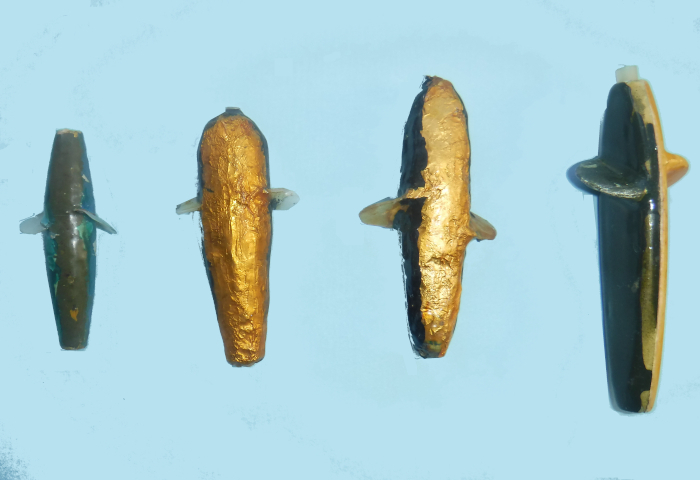
Fishing a wooden Devon minnow - the drop to the lead and the trace length can easily be varied.
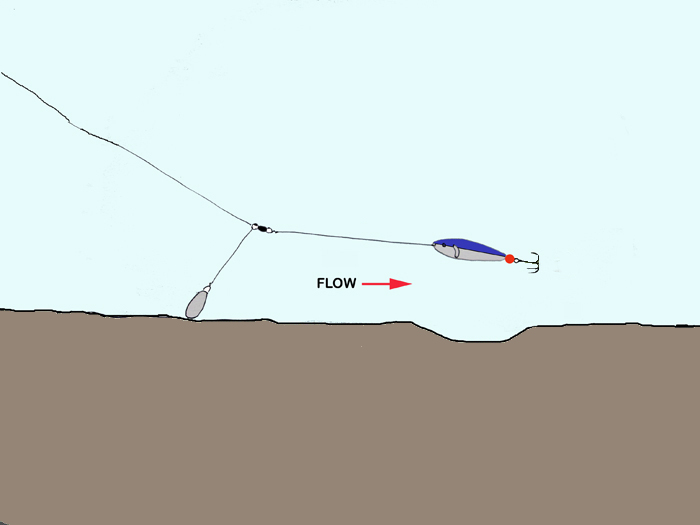
Having made or purchased a few streamlined wooden bodies and, drilled-out and lined them with plastic tubes, it is then necessary to fit fins (they are glued into slots sawn into the body). The fins can be made of metal, plastic or even rubber. It is possible that the softer materials may confer a slight advantage in the fact they are less likely to jam in the jaws of a taking fish; however, many salmon have been caught on Devons with metal or hard plastic fins. It would also seem reasonable to make fins as small as possible; ‘crescent-shaped’ fins being superior to ‘ear-like’ ones in this respect, but it must be remembered that larger and/or more steeply angled fins are required for use where the flow is slower. In general, an angle of about 60 degrees to the long axis of the minnow is a good compromise.
A bearing is needed to separate the central tube from the hook and for it to spin against. It is possible to buy custom-made bearings which fit over the eye of the treble hook, but these are much less effective than a simple plastic bead slid down the (18-20lb B.S.) Nylon mono. Although the former gadgets are supposed to keep the hook in line with the tube of the minnow, the extra friction is not worth the suggested advantage. A decent half-blood knot is perfectly adequate to keep the hook aligned with the trace. Materials other than soft plastic for beads are not worth considering because of the risk of damage to the nylon trace. The Devon is slid down the trace after the bead.
A simple, effective Devon mount (top); the others are poor, bought, versions.
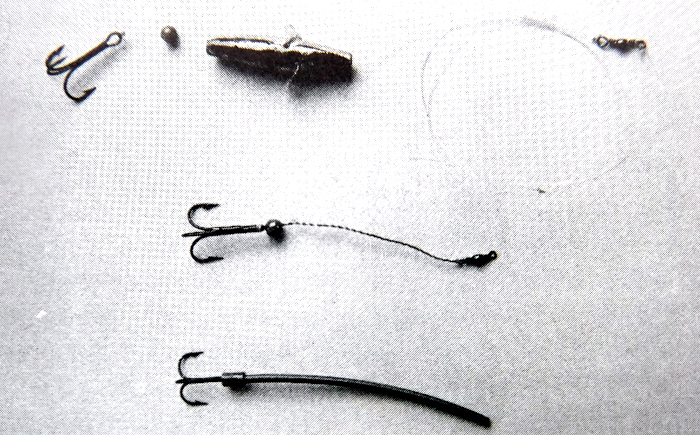
Treble hooks for use with Devon minnows should always be of high quality. Any extra cost is a small price to pay for total assurance in the hook-hold. It is hardly worth repeating that hooks should have a large enough gape to avoid being masked by the lure and should be kept needle sharp. A size 4, round-bend treble is a reasonable size for normal cigar-shaped, 2.5” to 3.0” Devons.
Large lure or small?
On the question of size of these fast- spinning lures I have few constructive suggestions. In general, on rivers which I have fished, salmon anglers used large Devons of, say, 3” early in the season when the water is deep and dirty. As it clears and falls, they will switch to smaller lures. The fact that even small grilse will (at least sometimes) take huge chromium or nickel-plated plugs of over 3.5” in length, suggests that even the rules which dictate the use of large lures in cold water and small lures in the warmer months are far from immutable.
The psychology of anglers probably accounts for some of the traditional attitudes to lures (for salmon and for other species) and it can do no harm at all to re-examine the dogma which is built up around our sport. Insofar as summer salmon are mainly grilse of only a few pounds in weight and the springers tend to be ‘submarines’, big baits in spring and small ones in summer might make sense. However, in the rivers which I have fished the warmer waters of summer do not make it essential to fish with tiny lures or baits. Frequently the large lures will be coloured in green and yellow halves (‘yellow-bellies’) and the smaller ones blue and silver. To obtain a metallic or highly-reflective finish the usual paint may be replaced with metal foil glued to the wood with contact adhesive and varnished. Suitable ‘gold’ or ‘silver’ paper is found on the wrappers of some chocolate bars. An alternative to chocolate-wrapping paper is the commercially produced ‘Flectolite’ tape, obtainable in various colours, which catch every glimmer of available light. This said, I have no evidence that any one of these colours is better than another. In the chalk rivers of southern England more large spring fish are probably caught on yellow-bellies than any other combination, but this is almost certainly because they are the most popular pattern in the early season. I have seen lots of fish caught on Devons painted almost every colour of the rainbow, and even on plain brown, wood-finish models which had lost every vestige of paint.
The easy option
Neutrally buoyant, Devon minnows do have some advantages as salmon lures. Most of these they share with other types, some are unusual: -
1. The Devon will fish at a distance from the riverbed which is fixed by the length of ‘drop’ to the lead.
2. The movement of the flowing water controls the action and vibration of the lure.
3. The lure attracts by both vibration and flash.
4. When a fish is hooked, the body of the lures slides up the trace (unless it is stuck on a fancy wire mount or plastic bearing). This leaves the fish attached by the hook alone, thus preventing any possibility of the lure acting as a pivot to break, straighten, or lever out the hooks.
To sum up, the rubber, plastic or (best of all) wooden Devon is a cheap, effective, and easily fished lure most useful in flowing water. The tendency to cause line twist, which is common to all fast-revolving spinners, is avoided by the standard method of attaching the trace to the lead with an ‘anti-kink dropper’ (achieved by attaching the lead link to the ‘front eye’ of the swivel). Only a single swivel is required in setting up the tackle.
Wooden Devon minnows can easily be made in any shape or size. I made myself an elongate, sandeel-shaped Devon (6” x 0.5”) which was used successfully from a dinghy at sea. By dangling the lure on a conventional rig in strong tidal currents I caught quite a few pollack and pouting. The problem with such a lure is the presence of only a single treble hook at the tail end. Many large predatory fish take their victims with a side-swipe, gripping them about mid-way along the body, thus potentially missing out on the hook. Fat, barrel-shaped Devons were referred to ‘by the late Colonel Crow, an avid salmon angler’ as ‘fat sprats’ and were believed (by him) to be particularly attractive to salmon. Again, my experience suggests that they are no worse (and no better) than the more slimline versions.
As already mentioned, the neutral-buoyancy Devon minnow is an easy lure to use because provided it is cast, more-or-less accurately, down and across the river, it will tend to ‘fish itself’. The rod is simply raised or lowered allowing the lead to bump its way across the riverbed with the lure sweeping slowly round in a wide arc and ticking over at a fixed height above the bed. When the tackle reaches the near bank, it is retrieved slowly. The depth, at this stage, is controlled by keeping the lead in contact with the bottom until the line is short enough to lift it for the next cast.
Because salmon often lie on the outside of river bends in deep, fast-flowing, water it is often possible to fish a Devon by what I call dangling. This method also depends on the tendency for these lures to 'fish themselves' in flowing water. The tackle is lowered under the rod point at the head of the run and, by repeatedly raising the rod quickly and lowering it back more slowly until the lead touches down, the tackle can be worked down each swim. A take may come at any stage and the fish will often hang itself on, as it grabs the lure and turns across the flow, setting the hook in its scissors.
One thing which is worth remembering when it comes to fishing deep bends is that the flow in such places is not a simple curve but a spiral. Salmon, which like most fish prefer to face into the flow, may lie with their heads towards the near bank. Consequently, when ‘dangling’, it is worth keeping the lead as close to the bank as possible.
Why do salmon take?
Having pointed out the virtues of the traditional wooden Devon minnow, it is worth considering whether this is in fact the ‘best’ lure for salmon fishing. Since our quarry is not feeding in freshwater, are there any useful criteria which we can apply to the choice of lure? The basic assumption is that a fish, fresh in from the tide, will respond best to something that looks like food, possibly a small fish, squid or prawn, a few inches in length. It is noticeable that after being in the river for a few weeks (or longer) fish tend to ‘lose interest.
Flies also look like food to a salmon fresh from the sea
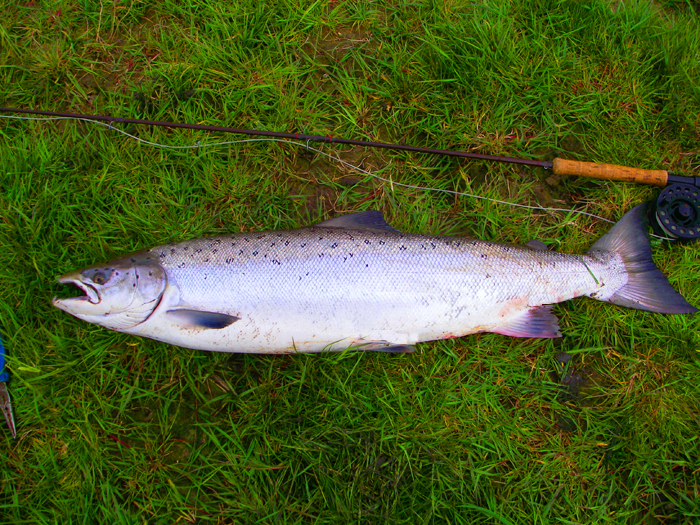
It seems likely that this ‘staleness’ and change in ‘feeding’ behaviour (reaction to lures) is related to the onset of breeding condition (development of eggs or milt; depletion of food and energy reserves; change from silver camouflage to spawning colours, and so on). There is precious little that any angler can do about this non-response except to observe that, like most biological changes, it probably progresses more quickly in warm weather. In the Autumn, towards or after the end of the salmon fishing season, there is a further change in condition of the fish as the (winter) spawning time draws near. The large, male salmon (in particular) develop aggressive, territorial, behaviour patterns and will at this time attack almost anything which enters their 'patch'.
'Stale' salmon, Autumn rises in water level often induce salmon to bite. Earlier in the season floods have little effect.
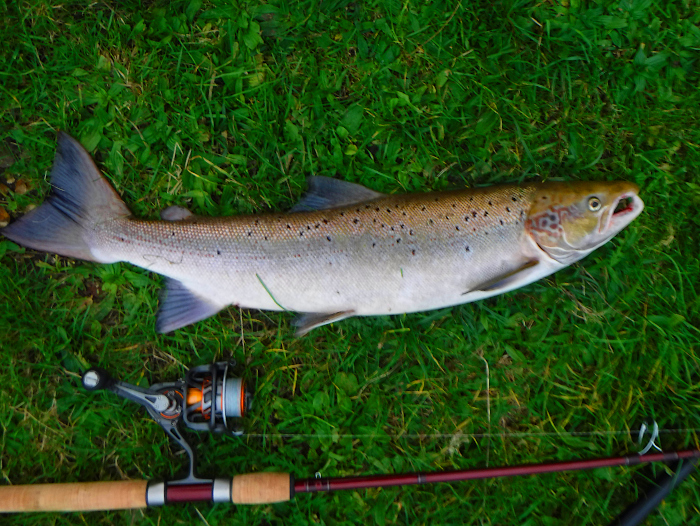
The paternal, protective urges of the male fish make them vulnerable to the angler, because they will chase and snap at almost anything. At this time in the season, it would seem that a large lure may be better, since the angler is trying to simulate a rival or intruder rather than offer an item of diet. Bear in mind that precocious parr (only 15-20cm in length) will attempt to fertilise the eggs of mature females, so large male fish may try to drive them away too.
In fact, the two largest salmon which I have ever seen landed, both massive fish of over 50 pounds, were big, red, male fish, one of which took an 8” plug, and the other a large spoon, being used for autumn pike. Just take a look at the game fishing magazines for confirmation - at the back end of the year, on those rivers where salmon fishing continues (here in Dorset it ceases at the end of August now), almost all the big salmon illustrated with their smiling captors, are clearly prospective fathers which mistook the anglers lure for a rival.
An accidental catch on a lure intended for seatrout.
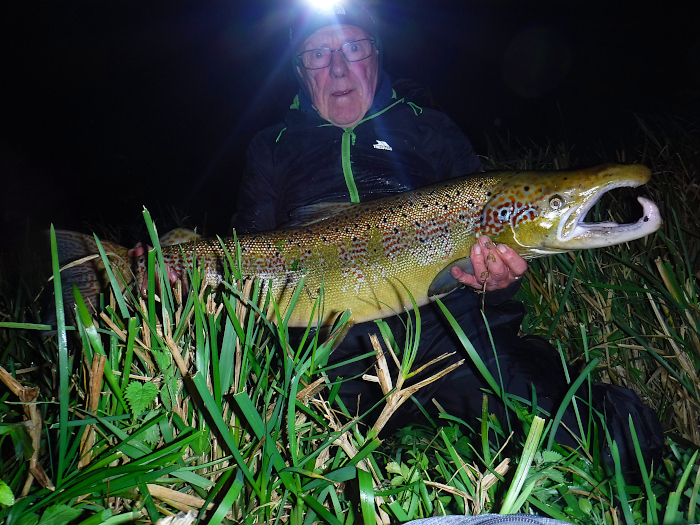
Spinners
To return to the matter of salmon lures, there are quite a few alternatives to the wooden Devon. Blade-spinners, are very effective salmon attractors; both the simple ones, like the Mepps with its weighted bar and the version with a soft, rubber fish attached to the back end. The Mepps-mino is (or was – it’s years since I used one) the best of the latter type. In using spinners, the principle is the same as that which applies to Devon minnows. It is better to use a relatively lightweight spoon than a heavy, fast-sinking one. However, the unweighted or lightly weighted shaft may cause excessive line twist and the version with the rubber fish is an excellent compromise.
The Mepps-Mino, once popular and no doubt still effective.
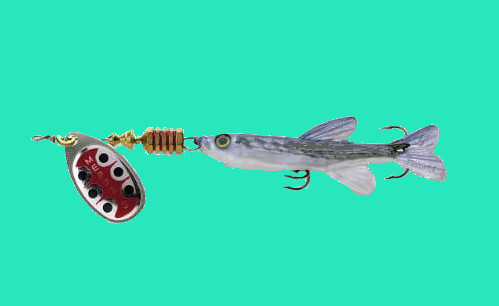
Spinners can be fished down-and-across in the conventional fashion, but generally it is more effective to cast upstream or up and across and, by retrieving slightly faster than the flow, keep the blade turning. How can you judge the pace of the current? In fact, it is easier than it sounds. Cast, and allow the lure to sink to the desired depth; Give a jerk with the rod to start the blade turning and, maintaining the line taut, reel just fast enough to keep the lure spinning. A little too slow and the decrease in tension on the line tells you that the lure is no longer working. Salmon will frequently chase spinners fished in this way for a long distance and, on taking, will usually turn away and hook themselves. A small up-trace weight, a metre or so above the lure will sometimes help to keep it down (but to my mind it is just more ‘clutter’).
A spinner is easily fished up-and-across through the weed beds.
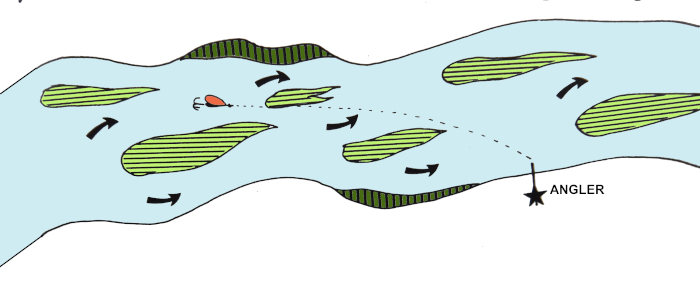
The versatile plug
There has been much controversy about the use of plugs for salmon fishing. In Dorset, these lures have, at times, been banned for all or part of the season on some rivers. Such restrictions are, in my view, difficult to justify, for plugs are in no sense unsporting and in fact they are the only artificial baits which can be fish fished most effectively on weightless tackle without swivels, traces or other paraphernalia.
A plug-caught salmon

Plug baits vary a good deal in form, ranging from simple curved metal or plastic 'bananas' (flat fish, wigglers, etc.), to unbelievably fish-like creations, shaped and painted to resemble particular bait-fish. For salmon fishing, there may be little point in trying to fish with an imitation of any particular species, although it seems probable that a fresh-run fish would respond best to a replica of the silvery, pelagic fish which it ate in its sea-going days (which certainly did not resemble green and yellow wooden cylinders). However, it is true that almost any plug will tempt fish. In my early years of salmon fishing, I often used the ABU Hi- Lo, one of the few commercially available plugs with an effective, adjustable lip, to allow fishing at different depths. The Hi-Lo is a slow-sinker with a rather chunky plastic body and a somewhat sluggish action - probably because it is made of rather dense materials. Despite their slow wriggle, these plugs caught lots of salmon. Blue ones, green ones, white ones with red heads, even luminous ones, all tempted their fair share of fish.
A Hi-Lo plug, with an adjustable lip, not a bad way to learn the ropes.
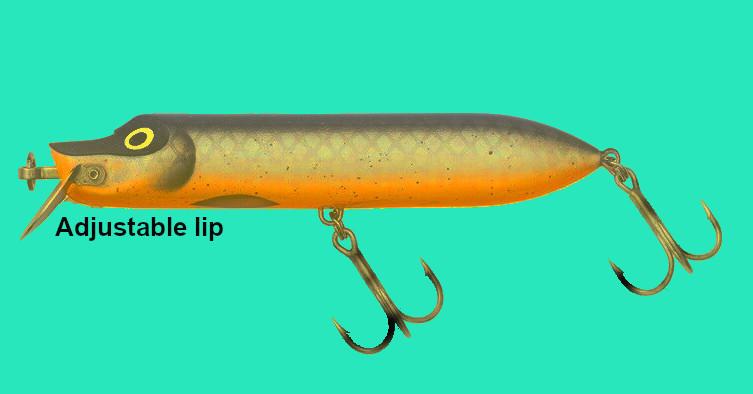
Another plug-caught fish.

Using the adjustable Hi-Lo was perhaps the best introduction to plug fishing which it is possible to have. The principle of the lip (scoop, diving vane) soon becomes clear when you can fold it up or down to order. It is immediately obvious that the action of the lure suffers when the lip is set to give a very shallow or very deep dive and that the best wiggle is in the middle range. It is also apparent that salmon (and other fish) will quite often take plugs which do not have much action at all when they are retrieved slowly or held steady in a gentle flow.
Salmon fishing in fast-flowing water, which, in places, may be several metres deep, gives scope for using fast-sinking metal plugs and one of the best of these is the Canadian Wiggler which, because it is made of heavy, brazed, metal pipe is at its most effective in strongly flowing water. All that is needed is to cast down and across the flow and, by using the rod, guide the lure through the most likely holding places. If it is known that a fish is in residence it is often possible to manoeuvre the plug to a point just upstream of it and to hold it in position, while it wriggles seductively in the current and is taken or rejected.
The Canadian Wiggler - effective in deeper, stronger-flowing water.

I have mentioned the ABU Hi-Lo and the Canadian Wiggler as plugs which catch salmon but, in practise, just about any plug will do the job. Some cheap, mass-produced, plastic types are pretty good attractors - but it is essential to ensure that the hook fixings and nose loop are truly secure. Tried and trusted lures of reputable make, such as Rapala, are generally totally reliable. The only way to be absolutely certain about the durability of your plugs is to make them yourself with a strong, all-through, wire-fixing. If D.I.Y. lacks appeal, these days there is a wide range of effective, high quality plugs. I’ve always found the Rapala range of balsa bodied plugs totally reliable in action, strength and security. They come with many variations of floating, sinking and with different degrees of dive and I still use them frequently.
Yet another fish on a Rapala. All the recently pictured fish were returned alive and well.
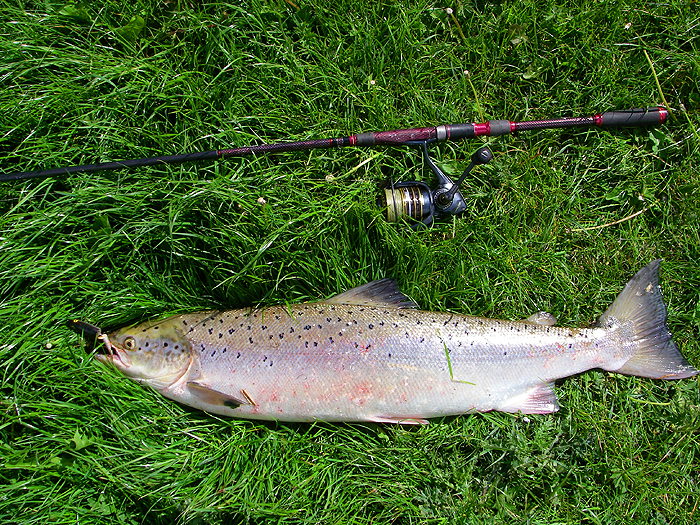
Finally, a few tips about the use of plugs. Normally they are attached using a small clip to allow free movement and easy change of lures. Simple, small clips of known breaking strain are the best for most situations; particularly because plugs should always be fished on the lightest practical line to enhance casting with no impediments to spoil their action. In these days of fine, strong, braided lines this is not a problem.
Occasionally, it may be useful to fish are buoyant plug, with a paternoster style rig which fixes the distance of the lure from the riverbed and allows it to be fished ‘straight up and down’ after the fashion of a wooden Devon. Like spinners, plugs can also be fished by casting upstream to good effect.
Success with spoons
One of the most popular salmon attractors is a simple spoon. ABU Toby spoons and other similar lures are widely used (in fact Hugh Falkus reckoned that these lures are the best attractors but not the best hookers). The main problem with metal spoons is that of adjusting the weight and size of the spoon to the depth and velocity of the water. Too small and light and the spoon skitters across the surface (but may still sometimes catch fish); Too heavy and you are straight into the riverbed. Traditionally, a salmon lure should be fished as deep as possible without hooking the bottom. If the riverbed is uneven, if the current is variable, or if there are lots of weedbeds present, perfect control of a simple spoon can be almost a work of art.
In general, a wide, flat spoon is easier to control than a narrow one of similar weight, because it will sink more slowly. However, only experience and long practise with these lures will give the necessary confidence to use them to the best effect. One excellent method is to lower them to the riverbed in a known lie, and by raising and lowering the rod point to fish them sink and draw, almost like a pirk.
Despite their drawbacks, spoons are good salmon lures. One of our pals never fished with anything else in the early part of the season. His best catch was two fresh-run springers in half-an-hour. For anyone who has the same faith as him, I can only say “stick to your spoons”. Plenty of information on their use and effectiveness can be found in the pages of the many books on salmon fishing.
This salmon took a large, wobbling, 'pike' spoon. Smaller spoons are better all-round.
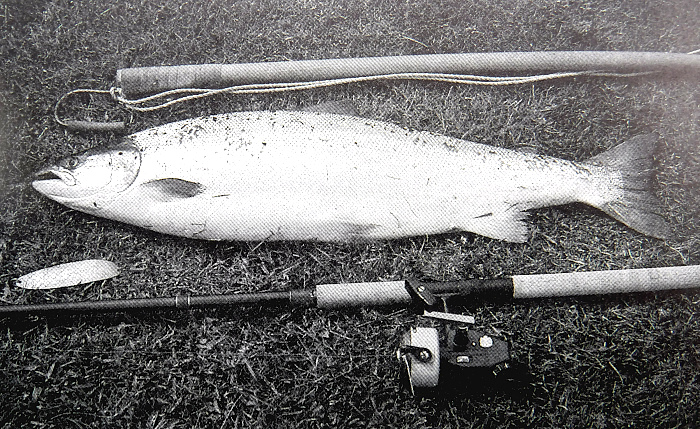
– PLEASE TELL YOUR TWITTER, FACEBOOK, EMAIL FRIENDS ABOUT THESE BOOKS.
ANGLING ON THE EDGE
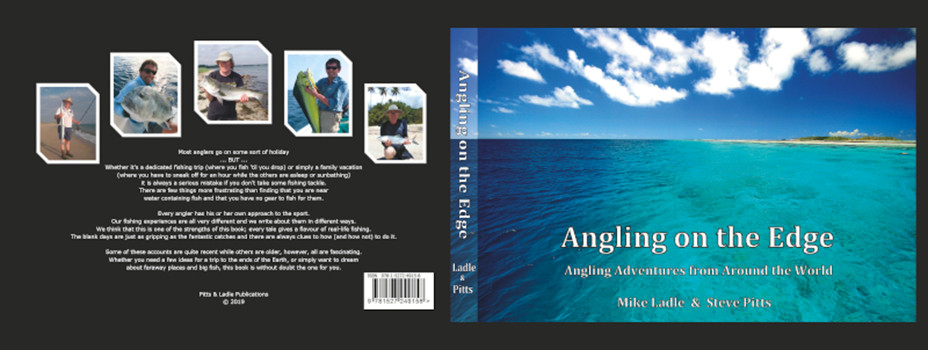
Copies can now be ordered (printed on demand) from Steve Pitts at £34.00, inc. Royal Mail Insured UK Mainland Postage.
To order a book send an E-MAIL to - stevejpitts@gmail.com
FISHING FOR GHOSTS
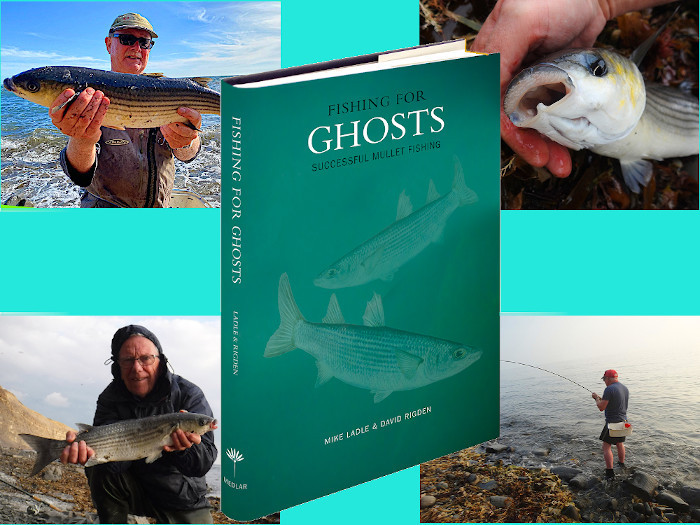
Written with David Rigden. Copies from
THE SECOND WAVE
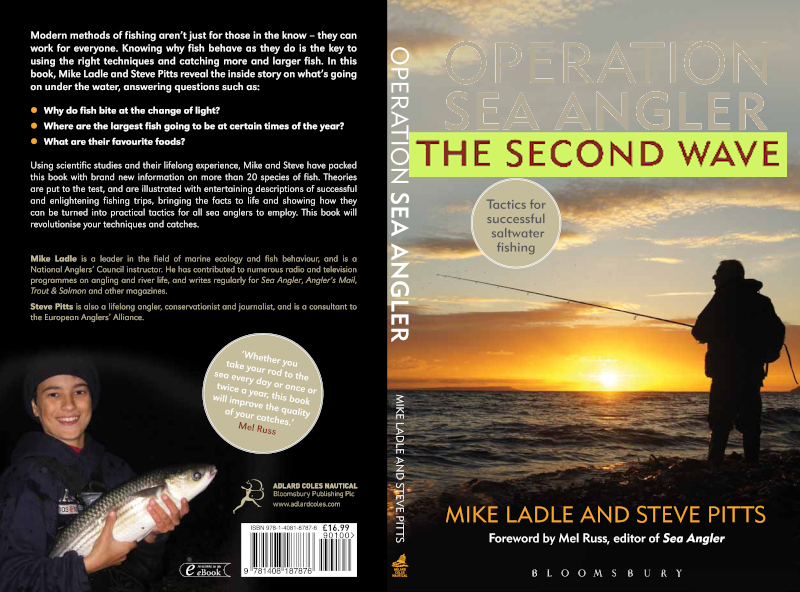
Written with Steve Pitts this is a SEQUEL TO THE BESTSELLER "Operation Sea Angler" IT'S AVAILABLE ON PAPER FROM -
If you have any comments or questions about fish, methods, tactics or 'what have you!' get in touch with me by sending an E-MAIL to - docladle@hotmail.com